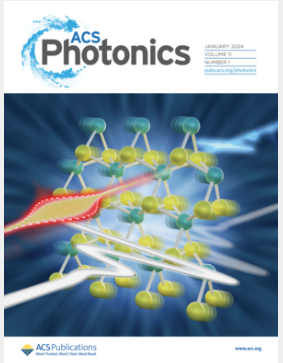六方氮化硼中单个缺陷中心的选择性反斯托克斯激发
IF 6.7
1区 物理与天体物理
Q1 MATERIALS SCIENCE, MULTIDISCIPLINARY
引用次数: 0
摘要
由于具有缺陷中心的六方氮化硼(hBN)的发射光谱显示出尖锐的发射峰值,并且在室温下表现出超亮的单光子发射,因此作为单光子发射器的理想候选材料而备受关注。然而,当使用波长短于目标缺陷中心发射波长的泵浦激光激发含有多个具有不同转变频率的缺陷中心的 hBN 时,往往会出现发射光谱宽和非单光子发射等问题。在本文中,我们提出了一种通过反斯托克斯激发来选择性激发 hBN 纳米片中单个缺陷中心的方法,即激发激光的波长长于目标缺陷中心的发射波长。通过使用 637 nm 激光激发具有多个缺陷中心的 hBN 纳米薄片(而不是使用 532 nm 激光进行正常激发),我们在二阶相关函数中观察到了一个尖锐的发射峰和一个反束倾角(g2(0) = 0.08 ± 0.05),这有力地证明了存在单个缺陷中心。此外,我们还探索了 hBN 纳米片中缺陷中心发射光谱的温度依赖性,以阐明反斯托克斯激发的机制。结果,我们证实单光子介导的反斯托克斯激发在抑制短波长发射和改善 g2(0) 方面发挥了重要作用。由于这种方法使用长波长激光进行激发,因此可以推测它不仅能大幅减少 hBN 纳米片内部产生的背景光子,还能大幅减少引导泵浦光的光纤中产生的背景光子,而这往往是一个严重的问题。本文章由计算机程序翻译,如有差异,请以英文原文为准。

Selective Anti-Stokes Excitation of a Single Defect Center in Hexagonal Boron Nitride
Hexagonal boron nitride (hBN) with defect centers is attracting attention as a promising candidate for single-photon emitters because its emission spectrum shows sharp emission peaks and it exhibits ultrabright single-photon emission at room temperature. However, when hBN containing multiple defect centers with various transition frequencies is excited using a pump laser with a wavelength shorter than the emission wavelength of the target defect center, problems such as a broad emission spectrum and nonsingle photon emission often arise. In this paper, we present a method for selectively exciting a single defect center in hBN nanoflakes by anti-Stokes excitation, where the wavelength of the excitation laser is longer than the emission wavelength of the target defect center. By exciting an hBN nanoflake with multiple defect centers using a 637 nm laser, as opposed to the normal excitation using a 532 nm laser, we observed a sharp emission peak and an antibunching dip (g2(0) = 0.08 ± 0.05) in the second-order correlation function, indicating strong evidence of a single defect center. In addition, we explored the temperature dependence of the emission spectrum from the defect centers in a hBN nanoflake to clarify the mechanism of the anti-Stokes excitation. As a result, we confirmed that single-phonon-mediated anti-Stokes excitation plays a substantial role in suppressing shorter-wavelength emissions and improving g2(0). Because this method uses a long-wavelength laser for excitation, it is speculated to substantially reduce the background photons generated not only inside the hBN nanoflakes but also in the optical fiber guiding the pump light, which is often a severe problem.
求助全文
通过发布文献求助,成功后即可免费获取论文全文。
去求助
来源期刊

ACS Photonics
NANOSCIENCE & NANOTECHNOLOGY-MATERIALS SCIENCE, MULTIDISCIPLINARY
CiteScore
11.90
自引率
5.70%
发文量
438
审稿时长
2.3 months
期刊介绍:
Published as soon as accepted and summarized in monthly issues, ACS Photonics will publish Research Articles, Letters, Perspectives, and Reviews, to encompass the full scope of published research in this field.
 求助内容:
求助内容: 应助结果提醒方式:
应助结果提醒方式:


